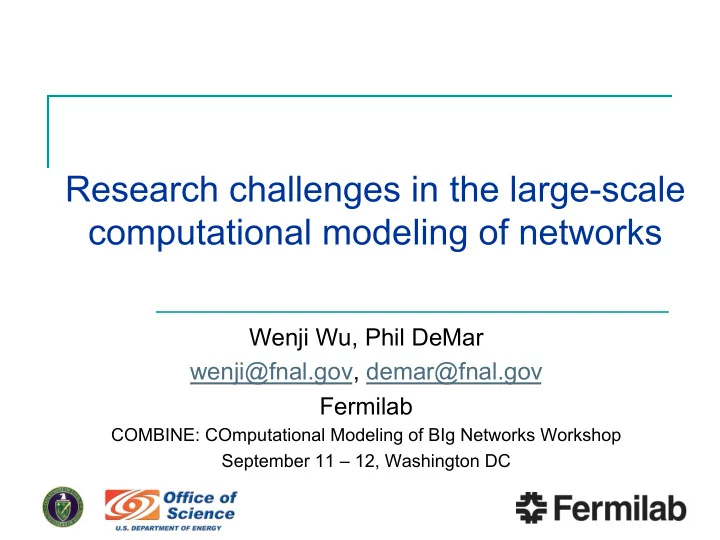

Research challenges in the large-scale computational modeling of networks Wenji Wu, Phil DeMar wenji@fnal.gov, demar@fnal.gov Fermilab COMBINE: COmputational Modeling of BIg Networks Workshop September 11 – 12, Washington DC
Topics n Previous network modeling & simulation projects n Research challenges in the large-scale computational modeling of networks n What are we interested?
Previous Network Modeling and Simulation Projects n Data Network Security Modeling & Simulation Project (partnered with Army Research Laboratory) q Design and Implement a whole package of IP network security attacking models using OPNET Modeler. ICMP Redirect Attack , ICMP Smurf Attack , ICMP Destination • Unreachable Attack , OSPF Max-Age Attack , OSPF Max-sequence Attack , • DSR Back-Hole Attack , DSR Selective-Forwarding Attack , and AODV • Deceiving-Route Attack etc. q The security attacking models are used to analyze the effects of information based network faults on TCP/IP networks.
Previous Network Modeling and Simulation Projects n Modeling and Simulation of Optical Networks Using a Virtual GMPLS-Based Optical Switching Router q Designed and modeled a Virtual Optical Switching Router (VOSR) using OPNET Modeler. q The VOSR models provide a framework to analyze and evaluate various wavelength routing and assignment algorithms in optical networks.
Previous Network Modeling and Simulation Projects n MANET-enabled OSPF Routing Protocol (Partnered with BAE Systems) q Develop and implement an MANET-enabled OSPF routing protocol. A new OSPF MANET (wireless) interface is designed to make MANET extensions to OSPFv2, adapting OSPFv2 to the wireless environment. The MANET-enabled OSPF enables a unified routing protocol for both wired and wireless networks. q The MANET-enabled OSPF is modeled and implemented with OPNET Modeler. MANET – Mobile Ad-hoc Networks
Research challenges in the large-scale computational modeling of networks
Network Modeling Methodology Understanding Understanding your Choosing aspects Defining input Start the system goals for the modeling to be modeled and output No No Result Specifying the Network model Result statistically accurate? system model verification (simulation) useful? Yes Yes End • Understanding what you are modeling • Granularity • Defining Data • Results
Challenge 1: Understanding what your are modeling n You must understand the proposed system to model it accurately. q The model cannot be more accurate than your understanding. q However, our goal is to better understand computer networks by using large-scale computation modeling as a research tool.. q The chicken and egg problem? an iterative and incremental process? Or both? n Understanding your goals. q What general questions do you want the large-scale computational modeling of networks to answer? n From the general questions, formulate specific research objectives.
Challenge 2: Choosing the Granularity Required n Granularity is the level of detail. n Choose a granularity sufficient to answer all questions. n Often, some portions of a model require fine granularity, and others much less. n How to make the optimal tradeoff?
Challenge 3: Model Verification n Are the models that I developed correct and accurate? n How can I validate and verify it? n Which data should I use to validate and verify my models?
Challenge 4: Scalability n Do existing network modeling & simulation tools scale to extreme-scale computing? q Ns2, ns3, OPNET Modeler
What are we interested? n Using network modeling and simulation as a tool to understand and facilitate q Distributed data management q Large-scale data movement
Recommend
More recommend